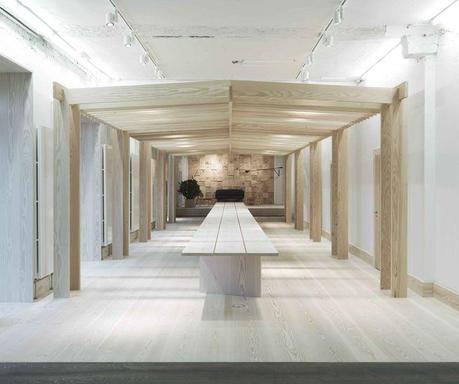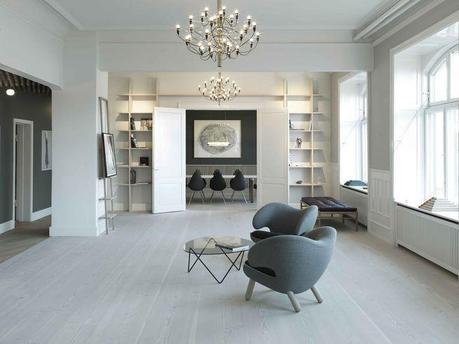
The main showroom and event space is defined by a 50-foot-long wood table, made from three, solid Douglas fir planks. Dinesen's signature, clean floors cover the entire showroom.
Image courtesy of Dinesen.In your own words, how would you describe Danish modern design?
Thomas Dinesen: I think Danish design is quite easy to understand. It’s designed with a reason. We are not going to design something to just make it; you should be able to use it for something. Also to make it sustainably, so that it will last. We try to make designs that will last for 100 years and will always be beautiful. I think that’s what we do.
Hans Peter Dinesen: It’s built for future generations and it’s honest to look at. The materials are honest.
You talk about sustainability a lot in your flooring. Is there a difference in the American market versus the European market for sustainable products?
Thomas: Some years ago, I had some customers ask me, are these floorboards going to last 10, 20, 100 years? Our floors would last minimum 100 years. We have this responsibility to the forest and the trees that are a hundred years old—so we have to use them in the right way. That’s also one of the reasons we have this new showroom. We want to show the wide and long floor boards but also the different options, the smaller planks.
Hans Peter: We want to use the leftover [pieces of wood] in a meaningful way. I’m involved in a project called Habitat. We provide nesting shelters for solitary bees. The honeybees are disappearing all around the world due to colony collapse disorder. But luckily 90% of all bees are solitary bees and they just need a place to stay. The wood is very good for nesting shelters, because the bees are attracted to the holes in the wood. So we want to engage in more of these types of projects, with nature conservancy and bio-diversity to promote our projects.
Where do you source your trees?
We get our trees from Germany. There are only about 3-5% that are big enough for Dinesen, and from these trees we use 5, 10, 15 meters and the rest of this wood is delivered to other showrooms that make normal planks or for building buildings. So we only get the best. And all forestry in Europe is sustainable. The man who owns the forest is also the man who sells the wood. So for us it’s important that if you get a big tree then you should use it in a responsible way.
What would be your dream project for Dinesen?
Thomas: I think I would like to have such a project that you see a person’s life from the beginning. During a financial crash, you can sell the furniture and the paintings but you can leave the floors, you can still live on them, sleep on them, walk on them, eat on them. And that’s it. Maybe years later, times are going to be better and new furniture comes in but the floors are a platform for your life, spaces for babies and grandpas and everything for every person. But the life of the floors is important.
Hans Peter: I think it’s important to provide trees to people who simply love the wood. That could be any kind of person. Not just an architect but everyday people.
What are your plans for Dinesen in the future?
Thomas: What gives us joy and happiness [is what's] important to us. So maybe we don’t have any long-term goals, but we want to act in a sustainable way and at the end of our day, we haven’t set any bad marks on the world. We don’t know how tomorrow is going to be; maybe someone will call us and say I have a project in Korea or New York or the Bahamas or outside our factory, we don’t know. We have an open mind for collaborations; we have a lot of designers and architects that we want to work with. So we don’t really know what will happen. Some architects say that Dinesen brings such a human touch to the project and maybe they will put Dinesen not on the floor but on the walls or the ceilling. We are ready to take new chances.
Slideshow

The showroom features distinct rooms adorned with Scandinavian designs. Finn Juhl's Pelican chairs, designed in 1940, create a sitting space.
Image courtesy of Dinesen.